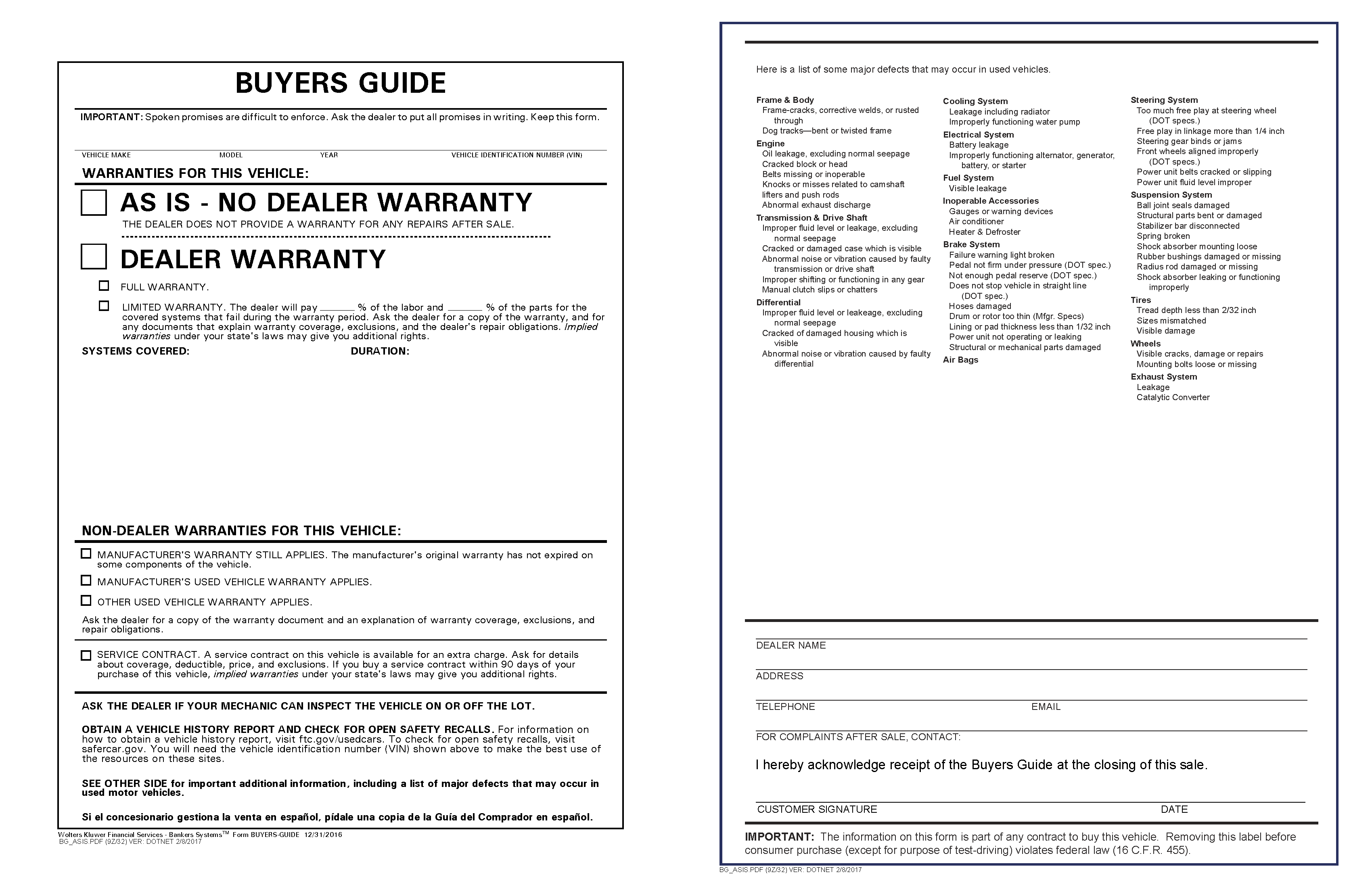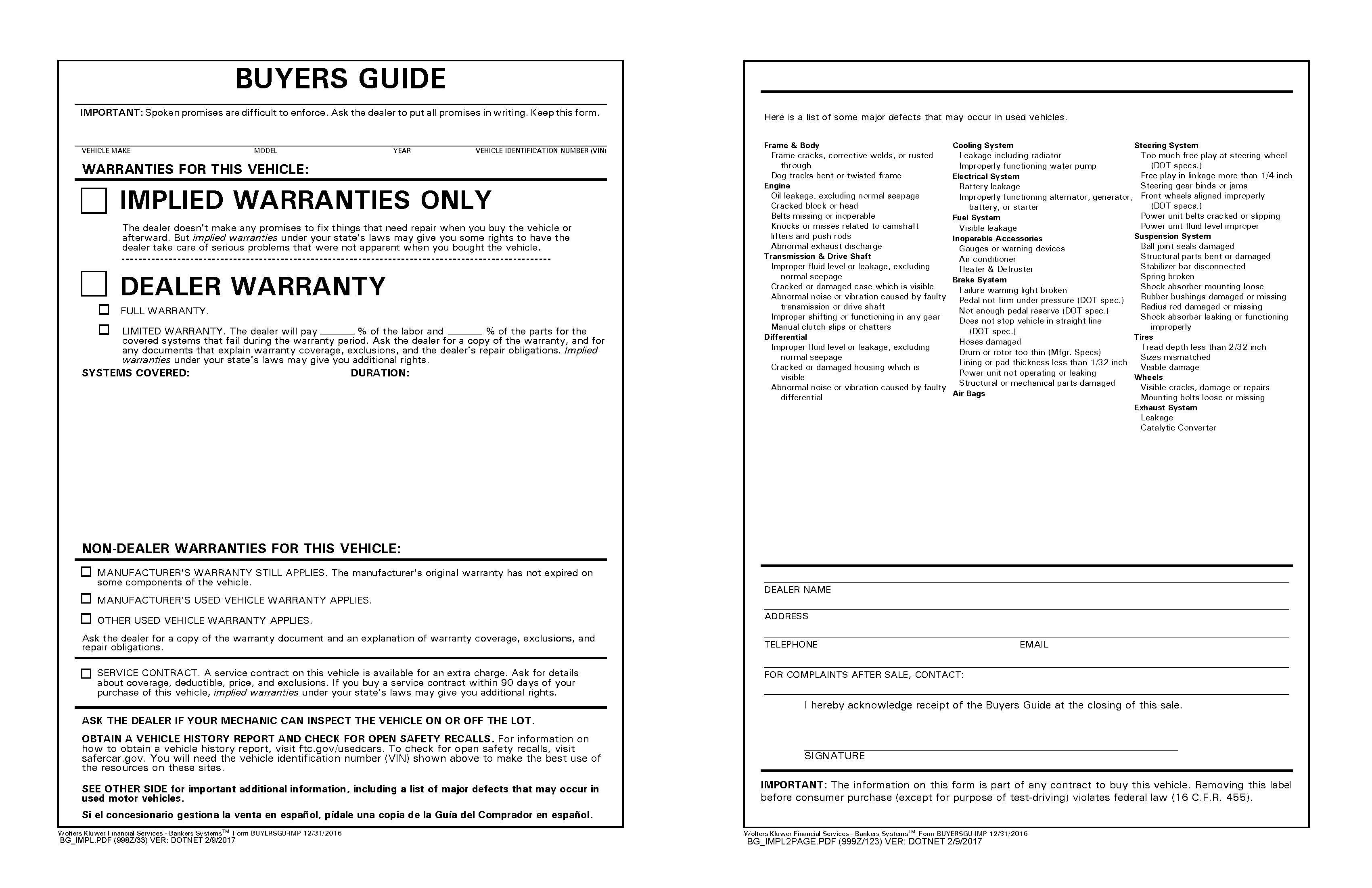Federal Buyers Guide – As-Is vs Implied Warranties
As always, this information is for reference only, and should not be construed to contain legal advice. The reader is responsible for employing qualified, licensed legal assistance before making any decision. See the Disclaimer Page.
What is the Buyer’s Guide?
Since 1985, Federal Law 16 CFR 455 (1-5), also known commonly as “The Used Car Rule,” states that any used motor vehicle within a certain size specification must disclose whether the vehicle is sold with or without a warranty. The rule specifies this must be done with a form placed “prominently and conspicuously” on the vehicle and “in such a fashion that both sides are readily readable.”1
Minor revisions were made in 2018 that allowed the Dealers to more plainly disclose whether there was a Dealer vs Manufacturers’ Warranty.
The Rule allows for states to require that motor vehicles must be sold with an Implied Warranty, and there is a version of the form that has that wording on it.
Buyers Guide Implied Warranty
Buyers Guide As-Is, No Warranty

As-Is Vs Implied Warranties
As-Is – No Dealer Warranty means simply that the consumer agrees to purchase the vehicle as it is, and agrees that any defects, whether obvious or not, will be repaired at the consumer’s expense.
Implied Warranty means that the Dealer must warrant that the vehicle is fit for the purpose intended and is merchantable.
Merchantable simply means that the product conforms to a reasonable and ordinary buyer’s expectations. If it is a motor vehicle, it should start, run, and do so without external assistance.
Fit for the purpose intended means that the product is guaranteed for a specific purpose. In this area of business, it generally means that a car will provide nominal transportation within the limitations of its’ design.
Fit for purpose intended also means, for example, that a vehicle designed for towing should be able to tow within the manufacturer’s specifications.
The Form
The form is specified by example in the Federal Law, and the only modifications permitted are that a signature line may be added.
The rule even requires that:
“The capitalization, punctuation and wording of all items, headings, and text on the form must be exactly as required by this Rule. The entire form must be printed in 100% black ink on a white stock no smaller than 11 inches high by 7 1/4 inches wide in the type styles, sizes and format indicated. “ 2
If the dealer conducts the sale in Spanish, the consumer must be given a Spanish version of the form.
The form must contain the Name and Address of the business, the Make, Model, Year, and VIN of the motor vehicle, and specifically, a name for complaints:
“The name and telephone number of the person who should be contacted if any complaints arise after the sale.” (455.2 (e)) Emphasis added .
This means that the dealer must put the name of a person who is authorized to handle complaints. The dealer cannot put “The Manager.” The rule says, “the name,” not “the title.” Fictitious names or attempts to prevent contact are not permitted.
The following things have actually been seen in that field:
“No Complaints Allowed”
“Helen Waite”
“A Shoulder to Cry On”
“Anybody But Us”
— Any of these could be construed by a regulator as an attempt to prevent the consumer from exercising his rights.
The form may not be removed from the vehicle prior to sale except if it interferes with a test drive.
The consumer must be provided a copy of the form at the time of the sale.
Dealers may be subject to penalties of up to $43,280 (2020 adjusted amt) per violation. Some states also have rules for the Buyer’s Guide and state penalties.
Other Info
The dealer and his/her agents should also be wary of creating Implied Warranties.
An example is the dealer who told a consumer that the car she intended to buy would “make it to California and back” (6000+ miles round trip from the dealership) in response to her expressed desire to have a trustworthy vehicle she could make an out-of-state trip in.
The consumer took the vehicle on a trip of about 500 miles, and the motor gave out several hundred miles from home. Even though the consumer signed an As-Is, the court held that the salesman created an Implied Warranty of Fitness for a Particular Purpose with his statement of the vehicles’ ability to make a 6000 mile round trip. The dealership not only had to pay for the engine repairs, it also had to pay for towing the car 400 miles back to their lot.
Another example is the salesman who looked at a customer’s boat trailer (large boat, dual-axle trailer) and declared that a Chevrolet S-10 with a 4.3 L engine “would haul that boat and trailer just fine.”
Not surprisingly, the transmission failed after a few trips. This court held that the salesman’s statement created an Implied Warranty of fitness for a purpose.
One consumer got an engine warrantied in spite of signing an “As-Is” form because the sales representative stated the Federal Buyer’s Guide was just “government red tape” and “didn’t mean anything.”
The attorney for the plaintiff produced several witnesses who all said the rep repeatedly told consumers the same thing, along with a promise that the dealer would “take care of” the car if anything went wrong.
Printing Note:
The form should be printed on two sides of a single piece of paper when it is intended to be signed by the customer and a copy given to them.

1 comment